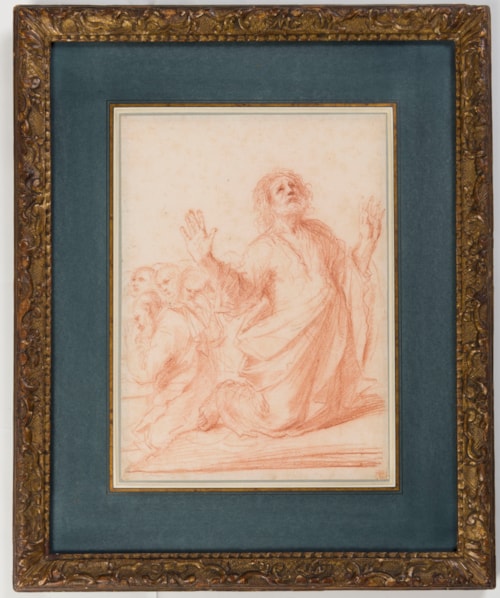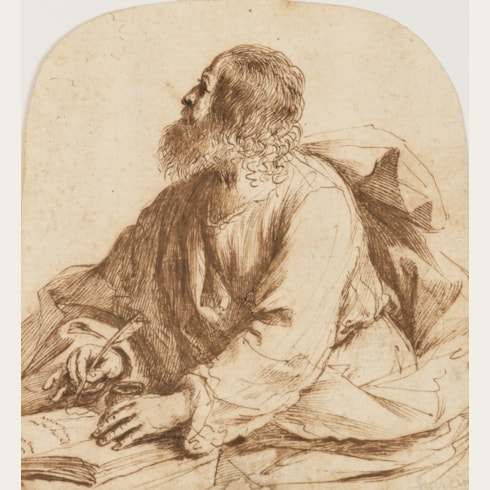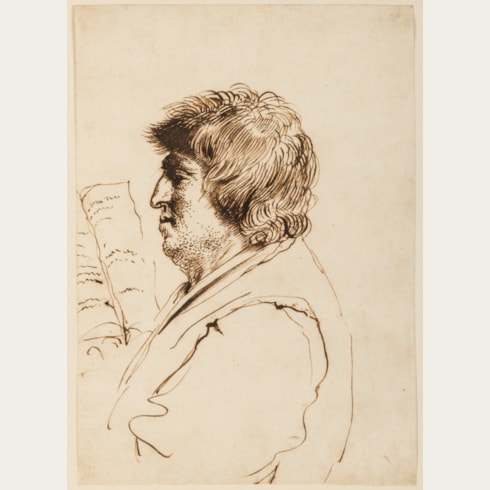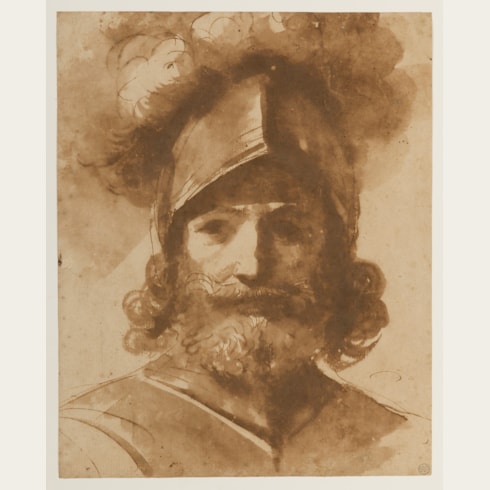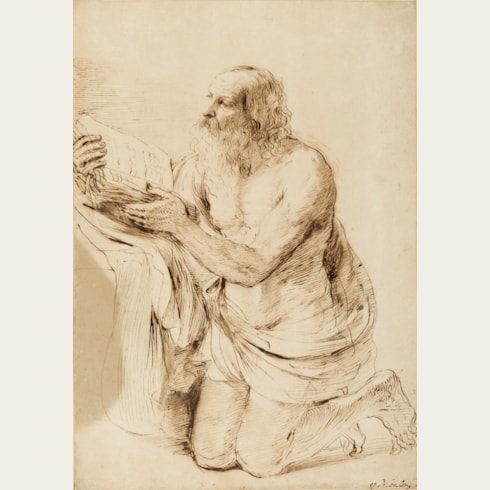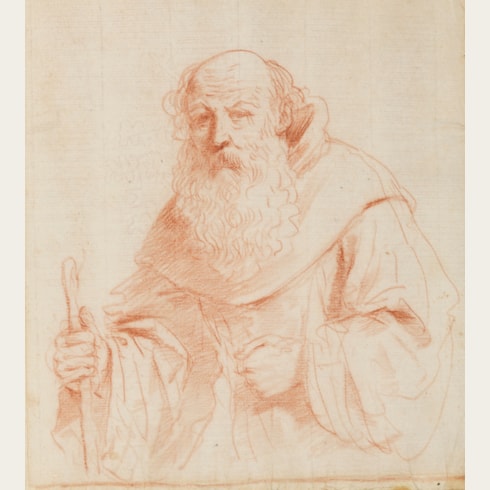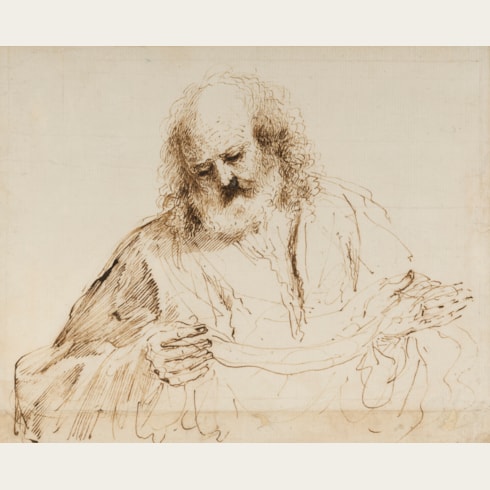Giovanni Francesco Barbieri GUERCINO
(Cento 1591 - Bologna 1666)
A Saint Kneeling in Prayer, with Other Figures Beyond
282 x 207 mm. (11 1/8 x 8 1/8 in.)
Watermark: Fleur-de-lys (similar to Churchill 372; Bologna 1654).
As David Stone has pointed out, with reference to both the Detroit painting and the present sheet, ‘one can hypothesize that instead of placing the apostles at the tomb in lontananza (in the distance), as Malvasia says and as Guercino actually painted them…along the lower edge of the canvas, the artist at first may have considered situating medium-size figures of the apostles in the middle distance and placing one full-size apostle (St. Peter?) in the foreground. The large apostle in [this] drawing stares transfixed at a miraculous sight overhead, which is clearly that of the ascendant Virgin, who has risen from the tomb where the other apostles – not yet aware of the assumption – have gathered to mourn…Owing to the higher price such a picture would inevitably have cost (since Guercino charged by the figure), it is possible that the client decided to eliminate the traditional scene from the foreground and to make do with just the Virgin, two large angels, and two putti (the equivalent of three and a half figures at 350 ducats.)’ The only preparatory study by Guercino that is undoubtedly for the Detroit picture is a double-sided red chalk sheet formerly in the collection of Mr. and Mrs. Morton Harris in New York and now also in the Detroit Institute of Arts. As Stone has pointed out of the recto of that drawing, one of the angels supporting the Virgin shows an interesting pentimento: ‘At first the angel on the left was looking down, as if he were observing the actions of the apostles below. However, almost certainly after the decision to remove the full-length apostles from the composition, Guercino redrew the angel’s head and body so that he now looks up towards the Virgin.’
Recently, however, a faithful painted copy of the Detroit painting, attributed to Guercino’s nephew and assistant Cesare Gennari, has been identified in the church of Sant’Antonio in Salsomaggiore, west of Parma. The Salsomaggiore painting includes more of the landscape at the bottom of the composition, which had been trimmed from the lower part of the Detroit canvas, and it is this landscape element that identifies the true subject of both the Salsomaggiore painting and the Detroit altarpiece as The Virgin of the Snow. The lower portion of the Salsomaggiore painting depicts the legendary miracle of the snowfall in August that marked the outlines of the future Basilica of Santa Maria Maggiore in Rome, with the patch of snow surrounded by numerous figures - the same figures previously assumed to be apostles in the Detroit painting – observing the miracle in amazement. Thus the angel noted by Stone in the preparatory drawing in Detroit can be understood to be gazing down at the snow on the ground.
The correct identification of the subject of the Detroit altarpiece as The Virgin of the Snow means that it cannot be the Assumption of the Virgin mentioned in the Libro dei Conti in 1650. Instead, the Detroit canvas can be identified with the only painting of The Virgin of the Snow listed in the Libro; a much later work commissioned by Guercino’s longstanding client Sebastiano Fabri, for which an initial advance payment or deposit was received on 7 May 1661. No other payments for this painting are recorded in the Libro, however, and the canvas seems to have remained in the artist’s studio after his death. The painting is next recorded in the 1690s, when it was being considered for purchase by Prince Johann Adam Andreas of Liechtenstein, but must have left the Casa Gennari before 1719, as it is not mentioned in the inventory undertaken that year.
Guercino’s 1650 painting of The Assumption of the Virgin, noted by both the Libro dei Conti and Malvasia as intended for an unknown church in Naples and long thought, incorrectly, to be the painting in Detroit, has very recently been identified by the scholar Massimo Pulini with a large altarpiece in the church of San Francesco in the city of Aversa, some twenty kilometres north of Naples. The Aversa painting is in very poor condition, and its composition is best judged in a reduced studio copy of the painting in the Catholic church of Our Lady of the Assumption in Latchford, a suburb of Warrington in Cheshire. The Aversa painting includes very small figures at the badly damaged bottom of the composition, which may be tentatively identified as the apostles. Thus Mahon’s supposition that the present sheet may have been a first idea for the apostles in the 1650 Assumption of the Virgin is still valid, albeit not for the painting in Detroit – which is now known to be eleven years later in date - but for the newly discovered Aversa painting instead.
The present sheet was among a large and important group of drawings in the Bouverie collection, described by the 18th century English collector Henry Reveley as ‘perhaps the finest collection of Guercino’s drawings in England…contained in about twelve volumes.’ Acquired in the 1740s from the Casa Gennari in Bologna by the British antiquarian John Bouverie (c.1722-1750), the collection contained numerous significant drawings by Guercino. As Nicholas Turner and Carol Plazzotta have noted, ‘drawings by Guercino with a Bouverie collection provenance share many features in common. They are in general in remarkably fine, even pristine condition, which implies, as Reveley was the first to observe, that they were very largely the drawings once preserved in the albums described by Malvasia as being in the master’s house…Although the drawings now at Windsor remain the single most impressive group of Guercino’s drawings in existence…[it contains fewer of] the more desirable pictorial composition studies in which the Bouverie collection was so rich.’
Giovanni Francesco Barbieri, known as Il Guercino (‘the squinter’) because he was cross-eyed, was by the second decade of the 17th century one of the leading painters in the province of Emilia. Born in Cento, a small town between Bologna and Ferrara, Guercino was largely self-taught, although his early work was strongly influenced by the paintings of Ludovico Carracci. In 1617 he was summoned to Bologna by Alessandro Ludovisi, the Cardinal Archbishop of Bologna, and there painted a number of important altarpieces, typified by the Saint William Receiving the Monastic Habit, painted in 1620 and now in the Pinacoteca Nazionale in Bologna. When Ludovisi was elected Pope Gregory XV in 1621, Guercino was summoned to Rome to work for the pontiff and his nephew, Cardinal Ludovico Ludovisi. It was in Rome that Guercino painted some of his most celebrated works, notably the ceiling fresco of Aurora in the Casino Ludovisi and the large altarpiece of The Burial and Reception into Heaven of Saint Petronilla for an altar in Saint Peter’s. The papacy of Gregory XV was short-lived, however, and on the death of the Pope in 1623 Guercino returned to his native Cento. He remained working in Cento for twenty years, though he continued to receive commissions from patrons throughout Italy and beyond, and turned down offers of employment at the royal courts in London and Paris. Following the death of Guido Reni in 1642, Guercino moved his studio to Bologna, where he received commissions for religious pictures of the sort that Reni had specialized in, and soon inherited his position as the leading painter in the city.
Guercino was among the most prolific draughtsmen of the 17th century in Italy, and his preferred medium was pen and brown ink, although he also worked in red chalk, black chalk, and charcoal. He appears to have assiduously kept his drawings throughout his long career, and to have only parted with a few of them. Indeed, more drawings by him survive today than by any other Italian artist of the period. On his death in 1666 all of the numerous surviving sheets in his studio passed to his nephews and heirs, the painters Benedetto and Cesare Gennari, known as the ‘Casa Gennari’.
The drawings of Guercino, which include figural and compositional studies, landscapes, caricatures and genre scenes, have always been coveted by later collectors and connoisseurs. Indeed, the 18th century amateur Pierre-Jean Mariette noted of the artist that ‘Ce peintre a outre cela une plume tout-à-faite séduisante’. The largest extant group of drawings by Guercino is today in the Royal Collection at Windsor Castle; these were acquired from the Gennari family by King George III’s librarian, Richard Dalton, between about 1758 and 1764.
Provenance
By descent to Cesare Gennari’s grandson, Carlo Gennari, Bologna
Probably Francesco Forni, Bologna
Acquired in the 1740s by John Bouverie, Betchworth, Surrey
By descent to his sister, Anne Bouverie, Betchworth, Surrey, until 1757
Her son, Christopher Hervey, London and Betchworth, Surrey, until 1786
His aunt, Elizabeth Bouverie, Barham Court, Teston, Kent, until 1798
Bequeathed to Sir Charles Middleton, later 1st Baron Barham, Barham Court, Kent
By descent to his grandson, Charles Noel, 3rd Baron Barham and later 1st Earl of Gainsborough of the second creation
His son, Charles William Francis Noel, 3rd Earl of Gainsborough, Exton Park, Oakham, Rutland
Thence by descent to Anthony Gerard Edward Noel, 5th Earl of Gainsborough, Exton Park, Oakham, Rutland
His sale (‘The Property of the Rt. Hon. The Earl of Gainsborough, removed from Exton Park, Rutland’), London, Christie’s, 23 November 1971, lot 103 (bt. Baskett & Day for 600 gns.)
Baskett & Day, London, in 1972
Private collection, San Francisco.
Literature
Exhibition



